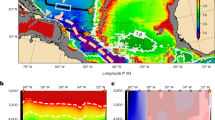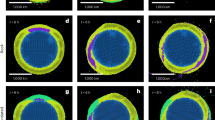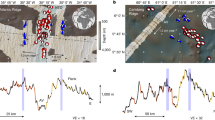Abstract
The tectonically driven closure of tropical seaways during the Pliocene epoch (∼5–2 million years (Myr) ago) altered ocean circulation and affected the evolution of climate. Plate tectonic reconstructions show that the main reorganization of one such seaway, the Indonesian Gateway, occurred between 4 and 3 Myr ago. Model simulations have suggested that this would have triggered a switch in the source of waters feeding the Indonesian throughflow into the Indian Ocean, from the warm salty waters of the South Pacific Ocean to the cool and relatively fresh waters of the North Pacific Ocean. Here we use paired measurements of the δ18O and Mg/Ca ratios of planktonic foraminifera to reconstruct the thermal structure of the eastern tropical Indian Ocean from 5.5 to 2 Myr ago. We find that sea surface conditions remained relatively stable throughout the interval, whereas subsurface waters freshened and cooled by about 4 ∘C between 3.5 and 2.95 Myr ago. We suggest that the restriction of the Indonesian Gateway led to the cooling and shoaling of the thermocline in the tropical Indian Ocean. We conclude that this tectonic reorganization contributed to the global shoaling of the thermocline recorded during the Pliocene epoch, possibly contributing to the development of the equatorial eastern Pacific cold tongue.
This is a preview of subscription content, access via your institution
Access options
Subscribe to this journal
Receive 12 print issues and online access
$259.00 per year
only $21.58 per issue
Buy this article
- Purchase on Springer Link
- Instant access to full article PDF
Prices may be subject to local taxes which are calculated during checkout



Similar content being viewed by others
References
Haug, G. H., Tiedemann, R., Zahn, R. & Ravelo, A. C. Role of Panama uplift on oceanic freshwater balance. Geology 29, 207–210 (2001).
Cane, M. & Molnar, P. Closing of the Indonesian seaway as a precursor to east African aridification around 3–4 million years ago. Nature 411, 157–162 (2001).
Haug, G. H., Sigman, D. M., Tiedemann, R., Pedersen, T. F. & Sarnthein, M. Onset of permanent stratification in the subarctic Pacific. Nature 401, 779–782 (1999).
Driscoll, N. W. & Haug, G. H. A short circuit in the ocean’s thermohaline circulation: A cause for northern hemisphere glaciation? Science 282, 436–438 (1998).
Steph, S., Tiedemann, R., Groeneveld, J., Sturm, A. & Nürnberg, D. in Proc. ODP, Sci. Results Vol. 202 (eds Tiedemann, R., Mix, A. C., Richter, C. & Ruddiman, W. F.) 1–51 (College Station, 2006).
Mudelsee, M. & Raymo, M. E. Slow dynamics of the northern hemisphere glaciation. Paleoceanography 20, PA4022 (2005).
Ravelo, A. C., Andreasen, D. H., Lyle, M., Lyle, A. O. & Wara, M. W. Regional climate shifts caused by gradual global cooling in the Pliocene epoch. Nature 429, 263–267 (2004).
Shackleton, & N. J., et al. Oxygen isotope calibration of the onset of ice-rafting and history of glaciation in the North Atlantic region. Nature 307, 620–623 (1984).
Gupta, A. K. & Thomas, E. Initiation of northern hemisphere glaciation and strengthening of the northeast Indian monsoon: Ocean drilling program site 758, eastern equatorial Indian ocean. Geology 31, 47–50 (2003).
deMenocal, P. B. Plio-Pleistocene African climate. Science 270, 53–59 (1995).
Marlow, J. R., Lange, C. B., Wefer, G. & Rosell-Melé, A. Upwelling intensification as part of the Pliocene-Pleistocene climate transition. Science 290, 2288–2291 (2000).
Lawrence, K. T., Liu, Z. & Herbert, T. D. Evolution of the eastern tropical Pacific through Plio-Pleistocene glaciation. Science 312, 79–83 (2006).
Dekens, P. S., Ravelo, A. C. & McCarthy, M. D. Warm upwelling regions in the Pliocene warm period. Paleoceanography 22, PA3211 (2007).
Ravelo, A. C., Billups, K., Dekens, P. S., Herbert, T. D. & Lawrence, K. T. in Deep-Time Perspectives on Climate Change: Marrying the Signal from Computer Models and Biological Proxies (eds Williams, M., Haywood, A. M., Gregory, J. & Schmidt, D.) (The Geol. Soc. of London & The Micropal. Soc., 2007).
Wara, M. W., Ravelo, A. C. & Delaney, M. L. Permanent El Niño-Like conditions during the Pliocene warm period. Science 309, 758–761 (2005).
Philander, S. G. & Fedorov, A. V. Role of tropics in changing the response to Milankovich forcing some three million years ago. Paleoceanography 18, 1045 (2003).
Fedorov, A. V. et al. The Pliocene paradox (Mechanisms for a permanent El Niño). Science 312, 1485–1489 (2006).
Chaisson, W. & Ravelo, A. C. Pliocene development of the east–west hydrographic gradient in the equatorial pacific. Paleoceanography 15, 497–505 (2000).
Rodgers, K. B., Latif, M. & Legutke, S. Sensitivity of equatorial Pacific and Indian Ocean watermasses to the position of the Indonesian throughflow. Geophys. Res. Lett 27, 2941–2944 (2000).
Tomczak, M. & Godfrey, J. S. Regional Oceanography: An Introduction (Pergamon, 1994).
You, Y. & Tomczak, M. Thermocline circulation and ventilation in the Indian Ocean derived from water mass analysis. Deep-Sea Res. 1 40, 13–56 (1993).
Shackleton, N. J. Attainment of isotopic equilibrium between ocean water and the benthonic foraminifera genus Uvigerina: Isotopic changes in the ocean during the last glacial. Colloq. Int. Cent. Natl. Rech. Sci. 219, 203–209 (1974).
Locarnini, R. A. et al. in NOAA Atlas NESDIS 61 (ed. Levitus, S.) (World Ocean Atlas 2005, Vol. 1: Temperature, US Gov. Printing Office, 2006).
Dekens, P. S., Ravelo, A. C. & Wara, M. W. AGU, Fall Meeting 2006 abstr. PP12A-07 (American Geophysical Union, 2006).
Ravelo, A. C. & Fairbanks, R. G. Oxygen isotopic composition of multiple species of planktonic foraminifera: Recorders of the modern photic zone temperature gradient. Paleoceanography 7, 815–832 (1992).
Ravelo, A. C. & Andreasen, D. H. in Reconstructing Ocean History—A Window into the Future (eds Abrantes, F. & Mix, A.) 217–244 (Plenum Press, 1999).
Gordon, A. L. & Fine, R. A. Pathways of water between the Pacific and Indian Oceans in the Indonesian seas. Nature 379, 146–149 (1996).
Gordon, A. L., Susanto, R. D. & Ffield, A. Throughflow within Makassar straight. Geophys. Res. Lett. 26, 3325–3328 (1999).
Martin, E. E. & Scher, H. A Nd isotopic study of southern sourced waters and Indonesian throughflow at intermediate depths in the Cenozoic Indian Ocean. Geochem. Geophys. Geosyst. 7, Q09N02 (2006).
Bruce, J. G., Quadfasel, D. R. & Swallow, J. C. Somali eddy formation during the commencement of the southwest monsoon, 1978. J. Geophys. Res. 85, 6654–6660 (1980).
Schott, F. A., Dengler, M. & Schoenefeld, R. The shallow overturning circulation of the Indian Ocean. Prog. Oceanogr. 53, 57–103 (2002).
Zheng, H., Powell, C. McA., Rea, D. K., Wang, J. & Wang, P. Late Miocene and mid-Pliocene enhancement of the East Asian monsoon as viewed from the land and sea. Global Planet. Change 41, 147–155 (2004).
Lisiecki, L. E. & Raymo, M. E. A Pliocene-Pleistocene stack of 57 globally distributed benthic δ18O records. Paleoceanography 20, PA1003 (2005).
Billups, K. & Schrag, D. P. Paleotemperatures and ice volume of the past 27 Myr revisited with paired Mg/Ca and 18O/16O measurements on benthic foraminifera. Paleoceanography 17, PA000567 (2002).
Gordon, A. L., Weiss, R. L., Smethie, W. M. Jr & Warner, M. J. Thermocline and intermediate water communication between the South Atlantic and Indian Ocean. J. Geophy. Res. 97, 7223–7240 (1992).
Gordon, A. L. Interocean exchange of thermocline water. J. Geophys. Res. 91, 5037–5046 (1986).
Timmermann, A., Justino, F. B., Jin, F.-F. & Goosse, H. Surface temperature control in the North and tropical Pacific during the last glacial maximum. Clim. Dyn. 23, 353–370 (2004).
Toggweiler, J. R., Dixon, K. & Broecker, W. S. The Peru upwelling and the ventilation of the South Pacific thermocline. J. Geophys. Res. 96, 20467–20497 (1991).
Sarmiento, J. L., Gruber, N., Brzezinski, M. A. & Dunne, J. P. High-latitude controls of thermocline nutrients and low latitude biological productivity. Nature 427, 56–60 (2003).
Liu, Z. & Yang, H. Extratropical control of tropical climate, the atmospheric bridge and oceanic tunnel. Geophys. Res. Lett. 30, 1230 (2003).
Schlitzer, R. Ocean Data View <http://odv.awi.de> (2007).
Acknowledgements
Samples for this study were provided by the IODP. Financial support for this research was provided by the German Science Foundation (DFG) within project Nu60/17-1. We thank J. Etourneau, S. Steph, D. Garbe-Schönberg, J. Groeneveld, M. Regenberg, N. Gehre and K. Kiesling for valuable comments and technical support. K.M. was supported by an IIT Kharagpur fellowship.
Author information
Authors and Affiliations
Corresponding author
Supplementary information
Supplementary Information
Supplementary Information (PDF 380 kb)
Rights and permissions
About this article
Cite this article
Karas, C., Nürnberg, D., Gupta, A. et al. Mid-Pliocene climate change amplified by a switch in Indonesian subsurface throughflow. Nature Geosci 2, 434–438 (2009). https://doi.org/10.1038/ngeo520
Received:
Accepted:
Published:
Issue Date:
DOI: https://doi.org/10.1038/ngeo520
This article is cited by
-
Sustained mid-Pliocene warmth led to deep water formation in the North Pacific
Nature Geoscience (2022)
-
The PhanSST global database of Phanerozoic sea surface temperature proxy data
Scientific Data (2022)
-
Mediterranean heat injection to the North Atlantic delayed the intensification of Northern Hemisphere glaciations
Communications Earth & Environment (2021)
-
Indo-Pacific Walker circulation drove Pleistocene African aridification
Nature (2021)
-
Evolution of tropical cyclone genesis regions during the Cenozoic era
Nature Communications (2019)



